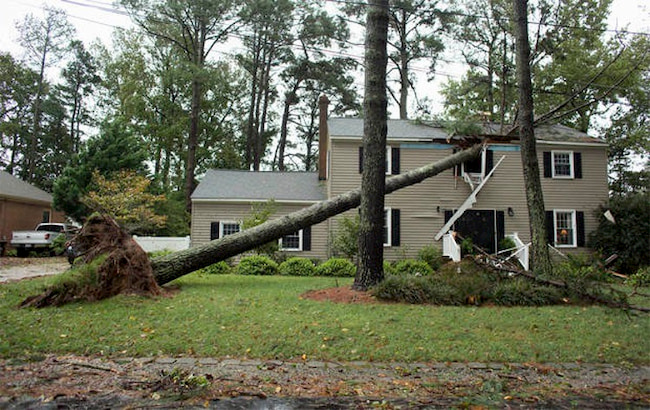Tree Removal Basics: Doing What's Best for Your Yard
Whilst tree removal is not always necessary, sometimes pruning or trimming is all the tree needs, there are signs that tell you when a tree needs to be removed. If the tree trunk is missing bark, has cavities and cracks then this is a strong sign that the tree needs to be removed. When there are large dead branches or if the tree starts leaning in a short period of time. If a tree has a hollow trunk, the presence of insects and odd growths and decaying or damaged roots then you should immediately get in contact with a tree removal service.
First they start wit an undercut - the undercut is a V-shape cut at a 45° angle made down at the bottom side of the tree. The undercut is made on whatever side the tree will be falling and it is cut about a quarter of the tree's diameter deep. Then they proceed with the backcut which is made on the opposite side of the undercut about 5 cm above it. The backcut goes straight through and releases the stress on the tree trunk which makes the tree fall.
The second method is done when a tree is close to utility lines and other structures. This involves an arborist climbing up the tree with a tree cutter in order to cut away sections of it, one piece at a time. After all the limbs have been cut, the bare trunk is cut into multiple pieces and lowered down to the ground either by dropping it or lowering it slowly using ropes.
The third method is the safest when it comes to handling a tree in a tricky location. Using a crane for trees removal is done by placing the boom (steel arm) over the tree so an expert climber would place cables on different parts of it. Once all the cables have been placed the climber will be lowered to make the cut and when the cut is made the crane operator slowly lifts the tree and places it on the landing zone.
Next what you want to do is test the soil or to be more exact its pH levels. This will help you determine what type of plants you can add back. If certain minerals have been depleted or if the acidity has been increased over the years you might want to avoid certain plants and grass or prepare the soil for them.
If you want to improve the soil, first you need to remove stones, roots and wood chips and smoothen out the ground with a pick saw. Ground limestone can help replenish important nutrients like calcium, zinc, phosphates and magnesium. You can also cover the whole with top soil, but do not exclude leaves, compost and grass clippings.
Tree Removal Process
How It's Done
When tree removal experts arrive the first thing they do is examine the tree as the removal largely depends on the state of it. The trees removal process also includes the clearing of the area around the tree in order for it to fall without causing any damage or even worse, injury. Tree removal experts plan an escape route in case the tree starts falling in an unexpected direction and gather their equipment before they start removing the treeFirst they start wit an undercut - the undercut is a V-shape cut at a 45° angle made down at the bottom side of the tree. The undercut is made on whatever side the tree will be falling and it is cut about a quarter of the tree's diameter deep. Then they proceed with the backcut which is made on the opposite side of the undercut about 5 cm above it. The backcut goes straight through and releases the stress on the tree trunk which makes the tree fall.
Methods
The above method is the simplest way to get a tree flat on the ground. This involves taking the height of the tree into account and whether or not there is enough space for it to safely fall down. There is usually a rope tied to the tree so that it can be pulled towards the direction it needs to fall.The second method is done when a tree is close to utility lines and other structures. This involves an arborist climbing up the tree with a tree cutter in order to cut away sections of it, one piece at a time. After all the limbs have been cut, the bare trunk is cut into multiple pieces and lowered down to the ground either by dropping it or lowering it slowly using ropes.
The third method is the safest when it comes to handling a tree in a tricky location. Using a crane for trees removal is done by placing the boom (steel arm) over the tree so an expert climber would place cables on different parts of it. Once all the cables have been placed the climber will be lowered to make the cut and when the cut is made the crane operator slowly lifts the tree and places it on the landing zone.
Benefits
Safety & Protection
A leaning or an overgrown tree can cause damage to your property and injuries as it runs the risk of falling over. A professional tree removal service prevents accidents from happening but it also helps avoid getting sewer lines and gutters damaged by developing roots. Removing trees can help protect your home from issues such as damage to the driveway, foundation, and even the pavement.Saves Time & Money
By not having to clean your yard after an accident or repair damaged walls or underground utilities you save on unnecessary expenses and wasted time. Tree removal services are actually quite affordable and a better option than to remove a tree all by yourself.Clean Yard
Trees can happen to shed more leaves than usual which can make for quite the mess. By getting them removed or trimmed (depending on the state of the tree) you can make your yard look cleaner and boost curb appeal. Also, too many trees in your yard can block sunlight which can make other plants perish as they won't be getting their daily dose of sunshine.What to Do After a Tree Removal?
If the stump of the removed tree is still in your yard it is recommended that you get rid of it. If the trees removal service does stump grinding too then it's best to have that done after the tree is removed from your yard. While some people want to make the most out of this situation, a tree stump can actually be the case of other underlying issues with your landscape.Next what you want to do is test the soil or to be more exact its pH levels. This will help you determine what type of plants you can add back. If certain minerals have been depleted or if the acidity has been increased over the years you might want to avoid certain plants and grass or prepare the soil for them.
If you want to improve the soil, first you need to remove stones, roots and wood chips and smoothen out the ground with a pick saw. Ground limestone can help replenish important nutrients like calcium, zinc, phosphates and magnesium. You can also cover the whole with top soil, but do not exclude leaves, compost and grass clippings.





Comments
Post a Comment